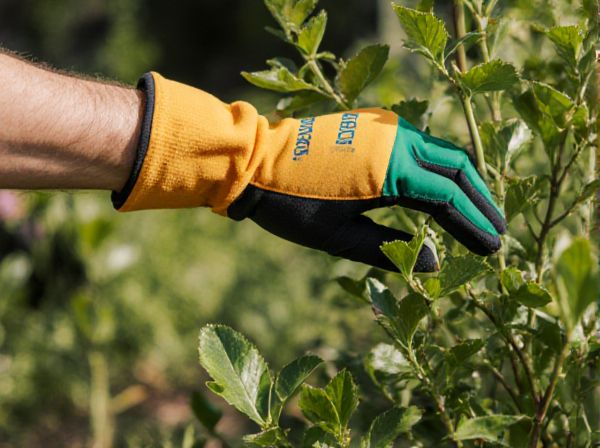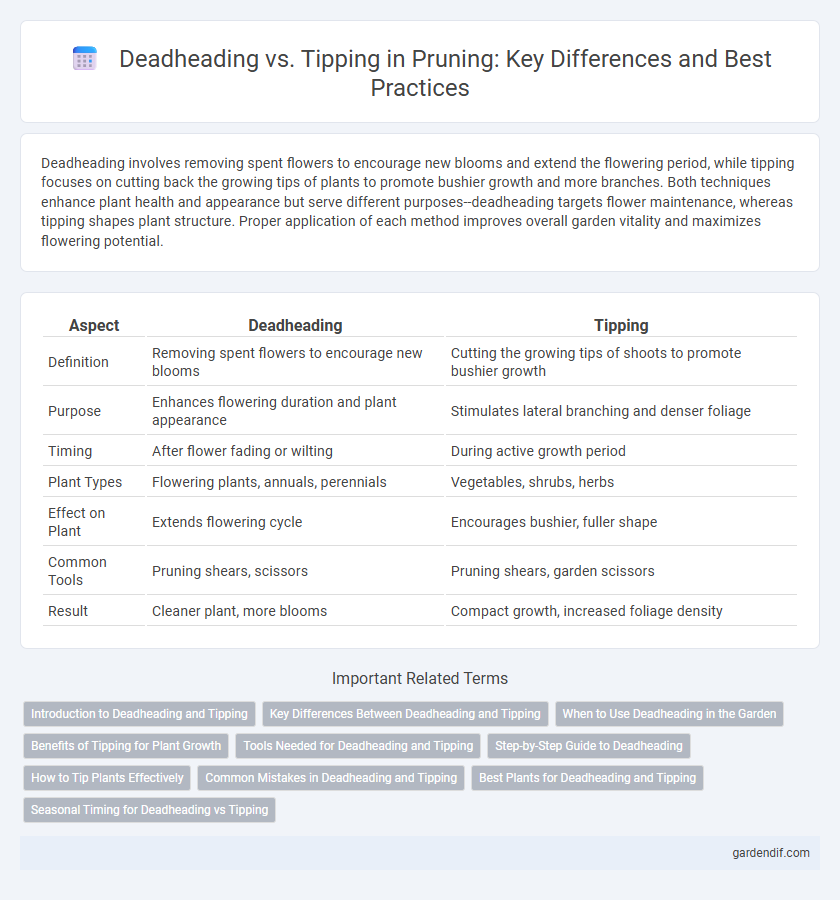
Deadheading vs tipping Illustration
Deadheading involves removing spent flowers to encourage new blooms and extend the flowering period, while tipping focuses on cutting back the growing tips of plants to promote bushier growth and more branches. Both techniques enhance plant health and appearance but serve different purposes--deadheading targets flower maintenance, whereas tipping shapes plant structure. Proper application of each method improves overall garden vitality and maximizes flowering potential.
Table of Comparison
| Aspect | Deadheading | Tipping |
|---|---|---|
| Definition | Removing spent flowers to encourage new blooms | Cutting the growing tips of shoots to promote bushier growth |
| Purpose | Enhances flowering duration and plant appearance | Stimulates lateral branching and denser foliage |
| Timing | After flower fading or wilting | During active growth period |
| Plant Types | Flowering plants, annuals, perennials | Vegetables, shrubs, herbs |
| Effect on Plant | Extends flowering cycle | Encourages bushier, fuller shape |
| Common Tools | Pruning shears, scissors | Pruning shears, garden scissors |
| Result | Cleaner plant, more blooms | Compact growth, increased foliage density |
Introduction to Deadheading and Tipping
Deadheading involves removing spent flowers to promote continuous blooming and prevent seed formation, enhancing plant aesthetics and vitality. Tipping refers to trimming the growing tips of stems to encourage bushier growth and increase branching density. Both techniques serve to optimize plant health and appearance but target different growth aspects.
Key Differences Between Deadheading and Tipping
Deadheading involves removing spent flowers to encourage new blooms and prolong flowering periods, while tipping refers to cutting the growing tips of plants to promote bushier growth and increased branching. Deadheading targets the removal of faded blossoms, whereas tipping strategically trims stems or shoots to control plant shape and vigor. Understanding these key differences allows gardeners to apply each technique effectively for desired plant health and aesthetics.
When to Use Deadheading in the Garden
Deadheading is most effective when flowers have faded and seed pods begin to form, encouraging plants to produce more blooms rather than setting seed. This pruning technique is especially beneficial for annuals, perennials, and roses, extending their flowering period and improving garden aesthetics. Regularly removing spent flowers also helps prevent diseases and promotes healthier, more vigorous growth throughout the growing season.
Benefits of Tipping for Plant Growth
Tipping stimulates bushier plant growth by encouraging lateral branching and increasing overall foliage density. Unlike deadheading, which primarily promotes flowering, tipping enhances structural development and improves light penetration within the plant canopy. This technique leads to stronger stems and healthier plants, supporting higher yields and better resistance to pests and diseases.
Tools Needed for Deadheading and Tipping
Deadheading requires tools such as pruning shears or garden scissors to precisely remove spent flowers without damaging the plant, promoting healthy growth and prolonged blooming. Tipping involves pinching or cutting the soft stem tips with fingers or small clippers to encourage bushier plant development. Using clean, sharp tools for both deadheading and tipping minimizes plant stress and reduces the risk of disease.
Step-by-Step Guide to Deadheading
Deadheading involves systematically removing spent flowers to promote continuous blooming and improve plant health. Begin by using clean, sharp scissors or pruning shears to snip just above the first set of healthy leaves or a leaf node, ensuring the plant can redirect energy efficiently. Repeat this process regularly throughout the growing season to maintain vibrant growth and prevent seed formation.
How to Tip Plants Effectively
Tipping plants effectively involves selectively pinching or cutting just above a leaf node to encourage bushier growth and increased branching. Use clean, sharp scissors or fingers to remove the apical tip, which redirects the plant's energy from vertical growth to lateral shoots. This precise technique enhances overall plant shape and promotes more blooms without removing spent flowers, unlike deadheading.
Common Mistakes in Deadheading and Tipping
Common mistakes in deadheading include cutting too close to the new bud, which can damage growth points, and failing to remove all spent flowers, leading to wasted energy and reduced bloom production. In tipping, errors such as cutting overly long stems or ignoring the plant's natural growth habit can result in weak structure and uneven foliage. Proper technique and timing optimize plant health and encourage vigorous, balanced development.
Best Plants for Deadheading and Tipping
Deadheading is ideal for flowering plants like roses, marigolds, and petunias that benefit from removing spent blooms to promote continuous flowering. Tipping suits herbaceous perennials such as coleus, mums, and basil, where cutting back stem tips encourages bushier growth and fuller plants. Both techniques optimize plant health and aesthetics by targeting species-specific growth patterns and flowering habits.
Seasonal Timing for Deadheading vs Tipping
Deadheading is best performed during the peak flowering season to promote continuous blooms by removing spent flowers, while tipping is typically done in early spring or late summer to encourage bushier growth by cutting back new shoots. Seasonal timing is crucial: deadheading focuses on maintaining plant vigor during active bloom periods, whereas tipping targets growth phases to shape the plant's structure. Understanding these seasonal roles improves pruning effectiveness and overall plant health.
Deadheading vs tipping Infographic

 gardendif.com
gardendif.com